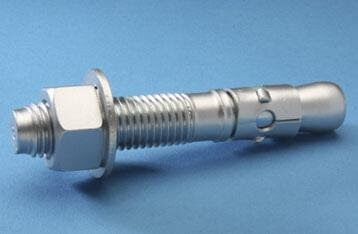The effective installation of wedge anchors calls for an ounce of decisive prevention to gain the proverbial pound of cure in the form of longevity for the application. In fact, a few ounces of moisture plus its substance will tip the scale toward the use of the 304 stainless steel wedge anchor, 316 stainless steel wedge anchor, or use of the hot-dipped galvanized wedge anchor.
Wedge anchors come in varied materials and types. Zinc plated carbon steel wedge anchors are among the most common. Other types include stainless steel wedge anchors and hot dipped galvanized.
When choosing wedge anchors made from specific materials or with particular finishes, it’s important to consider the environmental demands of the end installation. In moist environments, a careful judgment is critical to ascertain whether stainless steel or hot-dipped galvanized wedge anchors would provide the longer lasting corrosion resistance.
- Is it a wet or moist environment?
When a wedge anchor is needed, a practiced installer will inspect the environment carefully to decide if it is moist or wet. These few minutes of scrutiny will translate into years of rust resistance and durability for the completed job.
Wet environments can be either indoors or outdoors, and are submerged in liquid. This wet area will never be completely dried out, i.e., a sump pump. The 304 stainless steel wedge anchors will provide effective rust resistance in this type of atmosphere. Zinc wedge anchor might be used in wet applications but will rust over time.
Moist environments are also found both indoors and outdoors and are places that are temporarily submerged. The moist area will dry out, i.e., a fence post. The hot-dipped galvanized wedge anchor will have more rust resistance than even the mechanically galvanized wedge anchor, but not more than the stainless steel variety.
- Is it a caustic type of liquid?
Once the decision has been made that places the setting on the continuum of wet to moist, the next assessment concerns the liquid itself. Attentiveness to this detail will have long-ranging consequences on the endurance of the wedge anchor application.
Caustic, chemical and salt liquids will need the additional corrosion resistance offered by the 316 stainless steel wedge anchor, regardless of whether the application will be in a moist or wet environment. Swimming pools and food processing plants where cleaners are present are examples of where the 316 stainless steel wedge anchor is the most intelligent choice.
Comparing wedge anchors
304 Stainless Steel Wedge Anchors
- Used in submerged, wet environments
- Used only in solid concrete
- Spacing between each anchor must be more than 10 anchor diameters apart
316 stainless steel wedge anchors
- Used in caustic, wet and/or moist atmospheres
- Used only in solid concrete
- Minimum distance from an unsupported edge is five anchor diameters
Hot dipped galvanized wedge anchors
- Used in moist environments
- Used only in solid concrete
- Holding value depends on diameter of wedge anchor, depth of embedment; and the hardness of concrete base material increases holding value
Other considerations
Explore the opportunities to bypass the wedge anchor distributor. Tap into technology, and purchase directly from the manufacturer by ordering online at www.concretefasteners.com. This decision will produce savings of 30 to 70% over retail pricing. Sidestepping the purchase of wedge anchors from a distributor also offers the advantages of filling large quantity orders from a fully stocked inventory without the need for backorders. Online customers are given the advantage of free shipping with the delivery of orders within 1 to 3 business days.
Filed Under: News, O&M





